Setting up automatic late fees can really change the game for landlords. In fact, having a hassle-free process for screening tenants, reminding them of payment due dates, collecting rent, and charging late fees is crucial to running your business smoothly (and with fewer headaches).
This article will offer some insight into why setting automatic late fees is helpful and how to set them up properly for a hassle-free process.
Why Automatic Late Fees Are So Helpful
When it comes to late fees, it’s easy to let your emotions get the best of you and make exceptions for certain tenants because of their specific situations. But making these exceptions could cause a lot of problems in the long run, and you could find yourself being taken advantage of more often than not.
Automatic late fees can help you avoid these kinds of situations, so you don’t have to deal with any excuses from any tenant. If the rent is late, the fees are automatically charged, and you technically have “no control” over it. Automatic late fees don’t have emotions, and they don’t discriminate.
With automatic late fees set up, you don’t have to be the bad guy chasing tenants around for rent and charging expensive late fees!
Setting Reminders
Ideally, you want to avoid even having to collect late fees altogether. Finding ways to get tenants to pay on time can be tricky, especially without an online platform to automate the process for you.
Setting automatic reminders can really help prevent the need for late fees, as it lets tenants know ahead of time that rent is due soon and that they should prepare for it. Obviously, it’s not always 100% successful, but it will help prevent some tenants from simply forgetting.
In cases when tenants are in a difficult financial situation and cannot afford the rent by the due date, automatic reminders will give them enough time to figure out alternative solutions such as a rent credit loan.
Getting a rent credit loan is usually more desirable for tenants than paying late fees, as the interest rates on those loans are generally cheaper than the fees would be.
How do Auto-Late Fees Work?
Great landlord/tenant platforms like PayRent allow you to set up an easy and efficient rent collecting process. All you need to do is inform the system of how much money renters owe you and on what day, and how much to charge for late fees after how many days past the due date.
Once that’s done, the system takes care of it all for you. Best practices include allowing a grace period, setting a first-time late fee, setting a recurring late fee, and determining a reasonable maximum.

Grace Period
The grace period indicates how many days can pass after the rent due date before incurring late fees for non-payment. Typically, it’s three days, but the choice is really up to you and how many days you want to allow.
First Late Fee
This amount is the first late fee that will be automatically charged to the tenant once the grace period has passed.
Recurring Late Fee
You can set recurring fees for every day or week that passes after the rent’s initial due date. When you are using a platform like PayRent, you can select the fee frequency as you please, either daily or weekly.
Max Late Fee
Because some states limit the maximum late fee, landlord platforms usually have an option for setting this variable.
Easy Tracking of Tenants who Are Late
With automatic late fees, you are able to easily keep track of the tenants who are on time, those who are late and how much they owe, and even those who pay in advance. There is no need to chase around your tenants for payment.
In fact, when you decide to switch to a platform like PayRent to set up automatic rent reminders and late fees, you may quickly notice an increase in tenants paying their rent on time.
You may even get better feedback from your tenants and avoid certain conflicts that would typically arise when you have to personally reach out to them and notify them of the late fees yourself.










